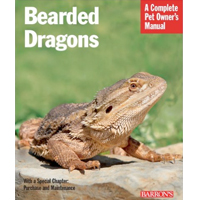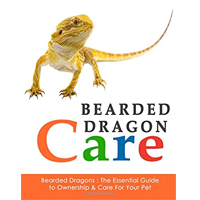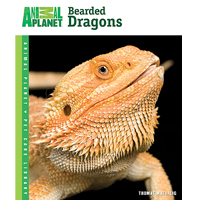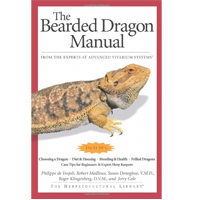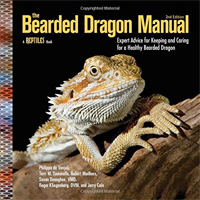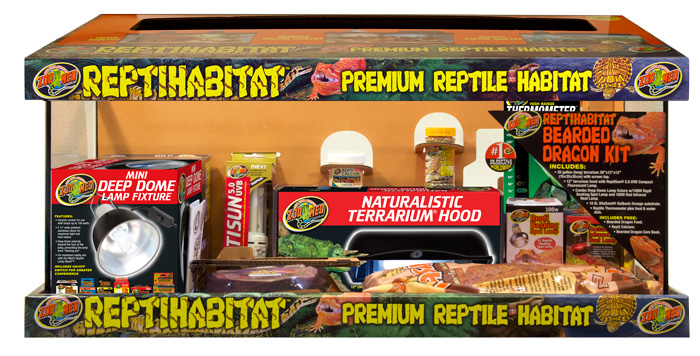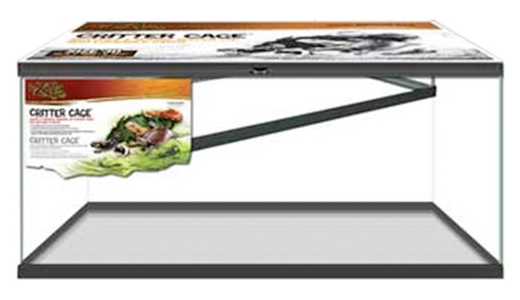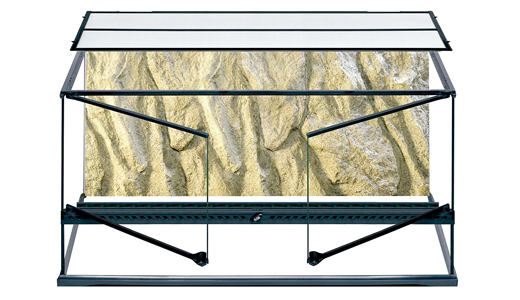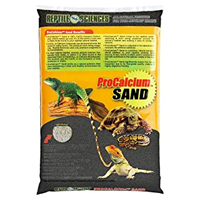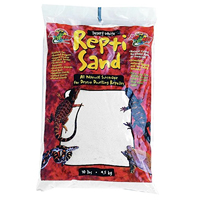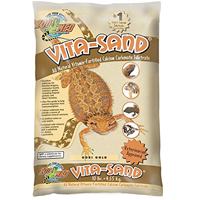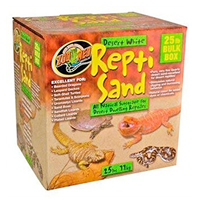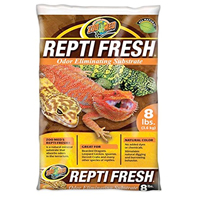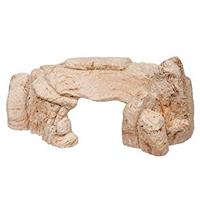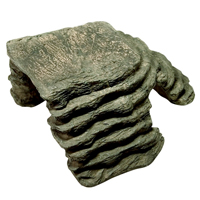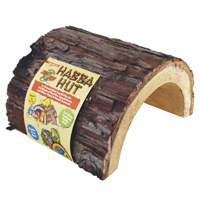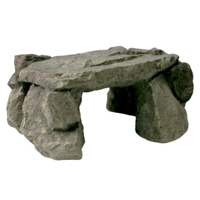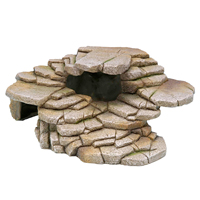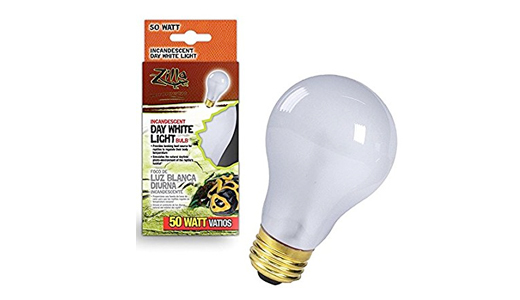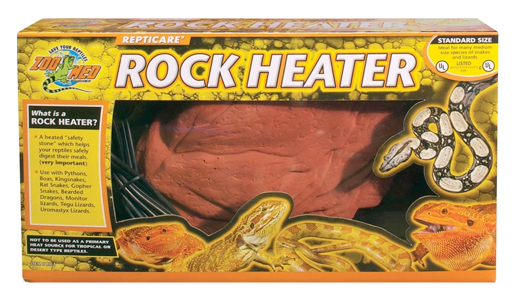Bearded Dragons Make Great Pets!
Bearded dragons are are attractive, active, entertaining, moderately-sized, easy to handle, naturally tame, and relatively easy to keep animal – which is why the bearded dragon has become such a popular pet. When compared to smaller reptiles, bearded dragons are robust and hardy. Compared to larger reptiles, bearded dragons are relatively safe for children to handle, although basic hygiene habits such as hand-washing must be practiced.
Bearded dragon is the common name applied to lizards of the genus Pogona in the family Agamidae, several of which display a beard-like extension of the throat when threatened. The bearded dragon that is most readily available in the pet trade, however, is the inland bearded dragon.
Two types of bearded dragons are commercially bred in small numbers: Lawson’s dragon and the eastern bearded dragon.
Lawson’s dragon is a smaller and naturally tame species. Unfortunately, it is not as easy to reproduce consistently as the inland bearded dragon is and is not readily available. The large eastern bearded dragon is rarely offered for sale as a pet because it has proven to be difficult to breed and presents certain problems in regard to long-term husbandry. Hybrids between inland bearded dragons and Lawson’s dragons are also occasionally offered for sale under the name of Vittikin dragons. Because the inland bearded dragon is by far the most popular, the information presented on this page will be about that specific type of bearded dragon species.
Inland bearded dragons now come in a variety of morphs including normal brown and tan dragons, German giants, vivid orange-red Sandfire lines, and pale hypomelanistic pastels and Snow/Ghost dragons. Other morphs can be expected to appear in the future as breeders constantly strive to introduce variety into the hobby. Prices of inland bearded dragons vary considerably depending on the age, type, color, and reproductive rate of the morph. You will have to evaluate which of the various kinds of bearded dragons is best suited for your purpose, whether as a pet, a living work or at, or as a source of revenue from breeding.
How To Build A Bearded Dragon Vivarium
When you obtain a new bearded dragon as a pet, it’s a good idea to pick up at least one of the following five books, which will walk you through the basics of bearded dragon ownership. These books are essential reading for any first-time owner of a bearded dragon.
Inside these bearded dragon pet care manuals you will find information on how to identify healthy bearded dragons, what size vivarium is best for a bearded dragon, what type of flooring to use inside your vivarium, which plants and hides your bearded dragon will enjoy most, how to heat and light your bearded dragon vivarium, what to feed your bearded dragon and how often to feed it, how to get your bearded dragon to mate with other bearded dragons, and a whole lot more.
You don’t need to buy all five of these books, but you should pick up at least one. We recommend – Bearded Dragons: A Complete Pet Care Owner’s Manual.
How To Pick The Best Bearded Dragon
Bearded dragons vary in personality. Some are more personable and responsive than others are. Some show more signs of intelligence. A very few are spunky from the time they are young, full of attitude, and readily displaying an open mouth in readiness to bite. A few of these spunky lizards can grow into nasty adult dragons, threatening to bite whenever you get near them. In their own way, these aggressive bearded dragons can be an endearing contrast to the typical pet dragon that is tame and placid.

As a general rule, young bearded dragons that are relatively large have less risk of dying than tiny hatchlings. For a first-time owner, a 6-8 inch juvenile bearded dragon that appears in good shape is a better long-term survival prospect than a 4-inch baby and is well worth the extra cost. If good color is important to you, selecting larger individuals well on their way to developing bright colors is the surest way of knowing what you may end up with you. Because bearded dragon breeders aim to keep groups consisting of one male and two or three females, excess larger males are commonly available and are ideal choices for those wanting a single pet. Occasionally, bearded dragon breeders offer older females at reasonable prices, but younger females are usually only available at much higher prices. Older female dragons are past their reproductive prime but still have several good years left as a pet, so they also make an excellent choice if you are looking for a female bearded dragon.
When looking for a healthy bearded dragon hatchling, please keep in mind that healthy baby bearded dragons will open their mouths and threaten to bite when a large hand or finger approaches them. This is normal behavior for a healthy bearded dragon. Also, look for a bearded dragon with rounded body contours and without any visible outlines of its skeleton – particularly along the spine and hip bones. Then, be sure to examine each of the digits to make sure they are all there.
Then, be sure to select a bearded dragon that is bright-eyed and either active or resting comfortably under a spotlight with its head and upper body raised. Make sure that both eyes are the same size and that there are no kinks or bends in the dragon’s neck, back or head. If buying your bearded dragon from a local pet store or breeder, ask to have the belly of the dragon presented to you so you can examine the belly and anus. The anal area should be flush with the body and there should be no brown fecal smears or caking around the anus.
Do not buy a bearded dragon that remains on the floor of its terrarium with its eyes closed. After brief periods of activity, sick and weak bearded dragons usually close their eyes and assume a sluggish posture. Along the same lines, pay attention when buying a bearded dragon from any cage containing a weak or ill bearded dragon. If most dragons in a tank appear unhealthy, do not buy a bearded dragon from that enclosure, because there is a good chance that the sick dragons will have infected the few that still appear healthy.

Do not pick a thin bearded dragon with a skinny tail and the visible outline of its hipbones. Also avoid any bearded dragon with depressions in the back of its head. Do not select a bearded dragon with fecal smearing around the best of its vent of the base of its tail. These dragons may be suffering with some type of internal parasite. Do not pick a runt or baby bearded dragon whose head appears bulbous in the back. It may eventually grow to be normal, but you would be starting off with an undersized or premature pet lizard. Also avoid babies that show repetitive opening and closing of the mouth and/or makes light popping sounds with its mouth. These are signs of a respiratory infection. Do not confuse this, however, with normal gaping performed when a dragon is starting to overheat under a basking light.
Finally, do not buy into the notion that you are going to save a poor, ill or runty bearded dragon. Most sick-looking baby bearded dragons die. If they don’t die, there is a good chance their owners end up spending quite a bit of money on veterinary bills to take care of their health problems. Nature doesn’t select for the weakest and neither should you! Keep in mind, that if you already have healthy bearded dragons, introducing them to a sick dragon could put them all at risk for contracting a disease.
How Much Space Does A Bearded Dragon Need?
Baby inland bearded dragons are just under 4 inches in length when born. They weigh about 1/10 of an ounce. The length of adult bearded dragons, however, is typically about 19-23 inches and they weigh at least ¾ of a pound. The German giant morph, is one of the largest types of bearded dragons and can reach lengths of 26 inches.
Bearded dragons kept in ideal conditions can increase in size at a mind-boggling 4,000 percent within six months of hatching. A baby inland bearded dragon will weigh about 0.08 ounces at birth, but by six months of age it will measure 12 inches long and weight about 4 ounces. That would be the same as a human baby growing from just 7 pounds at birth to 280 pounds in a period of just six months! Meaning that bearded dragons grow really fast, requiring more food than you may have first realized… and larger enclosures at an earlier age than at first seems necessary.
Bearded Dragon Viviarium Starter Kit
As adults, bearded dragons require an enclosure of at least 48 inches long, although we recommend a slightly larger vivarium measuring at least 72 inches long. If space, however, is a limitation, a bearded dragon may not be the best pet for you. Because bearded dragons require substantial amounts of food, including live insects, they defecate frequently, so enclosures and substrates have to be cleaned daily. If daily cage cleaning is a drawback for you, consider some of the smaller insect-eating lizards such as leopard geckos. If live insects are a problem, consider some of the skinks (such as blue-tongue skinks) that fare well on foods obtainable at your supermarket, or certain geckos (such as the crested geckos) that can be rained primarily on supplemented fruit purees or processed baby foods. However, if you have the space for bearded dragons, you will find that few lizards are more appealing, personable and entertaining.
Although bearded dragons seem to present less risk of disease transmission than some other reptiles, simple hygiene must be practiced if your home is to be shared with a bearded dragon. Reptiles often carry the Salmonella bacterium, which can be shed in their feces and may pose a disease threat to humans – especially infants, toddlers and those who are immune-suppressed. Reptiles should never be allowed on food-handling surfaces such as kitchen counters and dining room tables. Hands should be washed immediately after handling a reptile. Food and water bowls should be washed separately from household dished.
How Many Bearded Dragons Should You Get?
If you want a single pet, an individual bearded dragon will be enough for you, although makes in particular may display signs of social deprivation by displacing their social behaviors. They may, for example, head bob at you. Because bearded dragons are naturally social animals, a pair of male and female dragons is an ideal combination – as long as the bearded dragons are similar in size and similar in age.

While bearded dragon breeders maintain larger groups, using a ratio of one make to two females. In large walk-in enclosures, you can keep up to two makes and four females together. Although male adults and four females together. Although adult males will get into territorial and competitive engagements during the breeding season, they are usually not so aggressive as to cause serious harm to each other. Close observation is nonetheless always necessary to evaluate the compatibility of dragons kept in a group.
Baby bearded dragons raised in groups are very competitive and easily on will form hierarchies in which the tougher and larger animals will intimidate smaller ones, eat most of the food, and grow faster, making them even more intimidating and dominating. If small specimens are not segregated from larger species, the small ones will often hide, fare poorly, and even eventually become food for their bigger brothers and sisters. Close observation to evaluate the growth, health and welfare of individuals dragons is imperative!
What Type Of Bearded Dragon Terrarium Is Best?
Bearded dragons need lot more space than geckos and many of their other reptilian counterparts. That’s why we recommend that most bearded dragons be kept in a 20-gallon vivarium for larger.
Two of the best terrarium tanks for bearded dragons are: The large/wide Exo Terra All Glass Terrarium… and then Zilla 20-Gallon Critter Cage. Both of these bearded dragon vivariums can be purchased online and delivered to your home. Similar bearded dragon vivariums can also be found at your local pet shop.
If you aren’t yet ready to build a bearded dragon vivarium from scratch, the best thing you can do is to purchase the Reptihabitat Bearded Dragon Vivarium Starter Kit. This kit includes everything you need to successfully house your bearded dragon in your home. The kit comes complete with a glass vivarium, flooring, lights, heaters, food, a shelter for your bearded dragon, and a whole lot more! It’s certainly a good option for first-time bearded dragon pet owners.
The Best Flooring For Your Bearded Dragon
Because of the potential risks of bearded dragons eating sand and other flooring materials, many people choose to initially raise baby bearded dragons on newspaper. For bearded dragons over 8 inches in length, a silica-based, dust-free play sand (commonly used in children’s sandboxes) as a flooring substrate.
The easiest flooring for your bearded dragon is to have no flooring at all. Many bearded dragon breeders raise their babies on bare floors within plastic tubs or glass tanks. The advantages of bare floors include easy monitoring of stools, lack of hiding places for crickets, minimal risk of impaction, and less-intensive maintenance. Bare floor enclosures are easy to empty of landscape structures and can be moved outside for washing with a garden hose. A disadvantage is that the floors require regular wiping and cleaning. As the bearded dragon grows larger and messier, bare tanks become unattractive and tedious to clean. With larger animals, the hard, smooth floor surface can also lead to overgrown nails and bent toes.
Newspaper is the flooring of choice for quarantine and treatment of sick bearded dragons. Newspaper is cheap, readily available, easy to replace, and well-suited for examining feces. Many specialist recommend newspaper for initially raising babies because it allows monitoring of stools and eliminates any risks of impaction. The downside of newspaper is that it is visually unattractive, and regular or daily replacement can be labor intensive. If used with adult bearded dragons on a long-term basis, there is a risk of overgrown nails and bent toes.
![]() Sand is probably the best type of flooring for a bearded dragon vivarium. While sands of all types can be used with bearded dragons of all sizes, some bearded dragon owners have reported impaction with babies. For this reason, we recommend paper towels, newspaper, or brown butcher paper for hatchlings up to a length of 8 inches. After that size, sand is the most natural-looking and easy-to-maintain substrate for bearded dragons. If you can, purchase play sand, which is relatively dust free compared to the sand you might find at your local playground. There are, of course, other types of sand, including limestone sand, which is sold in the reptile trade and may work with bearded dragons. The main type of sand you want to avoid is any type of sand with calcium in it, as baby bearded dragons may lick the sand and the calcium can build up inside their body.
Sand is probably the best type of flooring for a bearded dragon vivarium. While sands of all types can be used with bearded dragons of all sizes, some bearded dragon owners have reported impaction with babies. For this reason, we recommend paper towels, newspaper, or brown butcher paper for hatchlings up to a length of 8 inches. After that size, sand is the most natural-looking and easy-to-maintain substrate for bearded dragons. If you can, purchase play sand, which is relatively dust free compared to the sand you might find at your local playground. There are, of course, other types of sand, including limestone sand, which is sold in the reptile trade and may work with bearded dragons. The main type of sand you want to avoid is any type of sand with calcium in it, as baby bearded dragons may lick the sand and the calcium can build up inside their body.
Finally, mixes of sand and soil work well with bearded dragons. But a problem with soil is that it can make dragon colors appear more brown and less colorful over time. Dust is also a problem. As with substrates of just sand, post cleaning is easy. Sandy soil must be replaced on a regular basis. In outdoor terrariums, natural soils make up the floor of most screen houses and greenhouses and generally work well with bearded dragons.
Bearded Dragon Cage Furnishings
Many new bearded dragon owners make the understandable error of landscaping their bearded dragon vivaria without any climbing areas. Not only does this limit the space available for your dragon’s activity, but also makes for a dull display.
Remember, inland bearded dragons are semi-arboreal and like to climb on rocks and dried wood. In Australia, they are often seen on the top of fence posts and rails. These perching sites can be reproduced in captivity by adding large sections of dried grape wood, fig wood, cork bark rounds, or rocks. Ledges along the back and sides of a tank can be created. These raised areas make ideal basking sites and most bearded dragon owners design them so that they are located under spotlights, which are above, but located outside the animal’s terrarium enclosure. At least one raised site should be provided per enclosure, but if you can squeeze in two or more raised areas, this allows your bearded dragon to pick its favorite spot and rotate between perches if it so desires.
In addition to the raised areas, you should also have plenty of open ground, maintaining at least two-thirds of the floor surface as open space. Bearded dragons also enjoy shelters for sleeping in at night or for resting in during the winter rest period. Big slabs of rounded cork bark work great for bearded dragon shelters because they are attractive, light and easy to clean.
Including a rough rock of some kind in your bearded dragon vivarium is a very good idea. In captivity, bearded dragons kept on solid surfaces or on soft substrates can end up with overgrown nails and digits that bend to the side. To prevent this, consider scattering rough pebbles on the flooring or adding flat sections of rough rock such as limestone to the landscape design. Lizards, like bearded dragons, wear down their nails by running or climbing on rock surfaces, so this is why it’s a good idea to have a rough rock inside your bearded dragon’s vivarium.
Finally, it’s a good idea to include a few plants in with your bearded dragon. Unfortunately, only a species of plants are tough enough to hold up to the abuse of bearded dragons. Our top plant picks include ponytail palms and snake plants – particularly the tougher ones with thick or cylindrical leaves that are more adapted to arid conditions.
Lighting & Heating For A Bearded Dragon Vivarium
Providing proper heating and lighting is essential to keeping your bearded dragon healthy. Their activity and metabolic processes depend on proper light and heat. Without them, your bearded dragon won’t be able to survive.
Providing adequate heat is critical to the welfare of bearded dragons. The primary source of heat should be a white (not red) incandescent bulb or spotlight in a reflector-type fixture capable of handling the wattage and heat output. A fixture with a ceramic base and no electrical switch in the base typically lasts longer for this type of use. Look for a fixture with a switch on the cord, or plug the fixture into a surge protector and use that switch to turn the light on and off. The light fixture should be placed above the screen top over the basking sites inside the vivarium. The temperature measured at the site should be in the range of 90 to 100 degrees Fahrenheit, and the bulb wattage should be adjusted provide the proper temperature. An alternative, however, is to use a higher wattage bulb and wire or plug the fixture into a light dimmer. This allows you to adjust the heat output of the light without having to adjust the distance in which the light hands over the bearded dragon terrarium.
As a secondary heat source, a hot rock type heater worked well with bearded dragons and should be placed away from the spotlight heat source in another area of the vivarium.
While artificial lighting is great for bearded dragons, the easiest way to provide UV-B to your lizard is to expose him or her to sunlight. And the safest way to expose them to sunlight is to use screen-side cages, which reduce the risks of overheating. A commonly used alternative is to place bearded dragons in large opaque or white plastic storage containers with a screen tip. Glass-sided, clear, or bare-floor plastic containers risk overheating and are often lethal to bearded dragons when placed in the sun. Instead, use sand and cover part of the terrarium with cardboard for shade. Even with screen-sided enclosures, you should always provide an area of shade for your bearded dragon so he or she can get out of the sun if necessary. Placement of outdoor basking cages is also important! Grass or soil is a safe place for these cages to be, but beware of concrete patios or asphalt surfaces, which build up heat in the sun and can kill your bearded dragon.
What Is The Best Place To Keep A Bearded Dragon?
In a few warm areas of the United States, bearded dragons can be kept in indoor screened or covered pens year-round, as long as they are provided with shelter from rain and have areas of soil or piles of hay to burrow into. Breeders have built effective pens inside greenhouses – but greenhouses should have controls for monitoring and maintaining desired temperatures including whitewash, opening panels, fans and heaters.
In most other areas of the United States, bearded dragons can be kept outdoors in simple pens during warm months. Make sure you build secure enclosures with screen or mesh tops to prevent escape and to keep out potential predators such as foxes, raccoons, cats and birds of prey. Inexpensive alternatives to pens are large plastic screen enclosures now sold in the reptile trade. They are ideal for allowing lizards to bask outdoors in sunlight. it is important not to place these all-screen enclosures on concrete or asphalt. Because both of these surfaces absorb heat when exposed to sun, bearded dragons may overheat and die if housed in a screen cage without shade, water and climbing areas.

Fun Facts About Bearded Dragons
- Bearded dragons get their name from their ability to make their throat look like a beard by puffing it out – usually when they feel threatened or in danger.
- The bearded dragon is also known as “Pogona,” which is its scientific genus name.
- There are eight known species of bearded dragon, but the most popular bearded dragons in the United States is the Central bearded dragon, otherwise known as Pogona Vitticeps. Most pet Bearded Dragon’s are Pogona Vitticeps.
- Bearded dragons usually lose their teeth in the wild, due to how they tear into their prey. Luckily, their teeth can grow back over time.
- Bearded dragons are diurnal creatures, meaning that like human beings, they are awake during the day and will sleep during the night.
- Bearded dragons are what is known as semi-arboreal creatures – meaning they spend at least some of their lifetime living in trees.
- Bearded dragons enjoy wading and swimming in water, despite the fact that there is little water in their natural habitat
- Bearded dragons have really good eyesight, making them able to see prey or predators over extremely long distances.
- In order to claim their rights to a basking spot, dominant bearded dragons will try and climb and even lie on top of a lesser bearded dragon.
- When they are in the wild, bearded dragons can often run on two legs as opposed to four when running away from predators. The additional height they get while doing this also helps to cool down their body temperature.
- Bearded dragons have a period of the year where they will rest more than normal, quite like a hibernation. In this time, they will sleep and rest a lot. This period is called a brumation.
- Bearded dragons are territorial creatures and can be quite aggressive to other bearded dragons who come onto their territory.
- Bearded dragons can change their color to help them regulate their body temperature and to help hide themselves from predators. They usually change to a lighter color which helps to deflect sunlight. This is very useful for bearded dragons when they are living in the desert.
- A bearded dragon has the ability to sleep standing up, as it can hold its legs in a locked position.
- Male bearded dragons can grow up to 24 inches in length, while females can grow up to 20 inches in length.
- Bearded dragons are very quick when they have to escape from predators and are very fast runners. A bearded dragon can run up to 15.5 kilometers (or 9 miles) per hour
- Baby bearded dragons measure around 4 inches in length when they are born and weigh only 2 grams, which to give you some perspective, is the weight of just five paper clips.
- The tail of a bearded dragon makes up almost half its total length.
- Bearded dragons are omnivorous, which means they eat both live food and fruits and vegetables.
- Unlike other types of lizards, a bearded dragon’s legs and tail will not grow back if cut off for any reason.
- In captivity, bearded dragons usually live for around 10 years, while they normall live for about 12 years when living in the wild.
- Female bearded dragons have been known to hold sperm within their bodies for up to 2 years, which means that they don’t have to mate in order to lay eggs.
- Bearded dragons are cold blooded animals, which means they rely on heat sources (such as the sun) to keep their body temperature where it should be.
- Bearded dragons like to live in climates allowing them to be at 80 – 90 degrees fahrenheit during the day, and around 70 degrees fahrenheit at night.
- Bearded dragons come from South-East Australia and live in semi-desert environments.
- Male bearded dragons will breed with multiple females, if given the opportunity.
- Bearded dragons have up to 24 eggs at a time in one clutch… and they can lay up to nine clutches in a single year.
- Although bearded dragons love to eat, they can actually go for weeks without eating and so can survive in the most harsh of environments where there isn’t anything to eat.
- When a bearded dragon gets too hot, they will bask with their mouths wide open, almost like a panting dog – in order to try and cool themselves down.
Photos by: Linda Stanley, L Church, Steve Jurvetson, Koronna Lacasse, Dave Taylor, mrossmedia, Ultima_Bruce, Andreja v., ickle110, Ultima_Bruce, nakedcameraguy, Dan Lynch, tah/venuti, Shaun Stafford,

